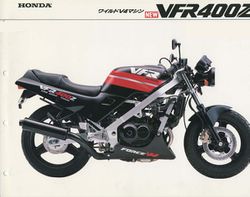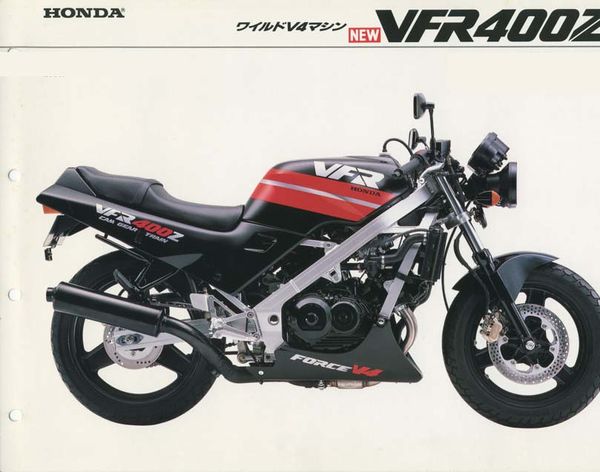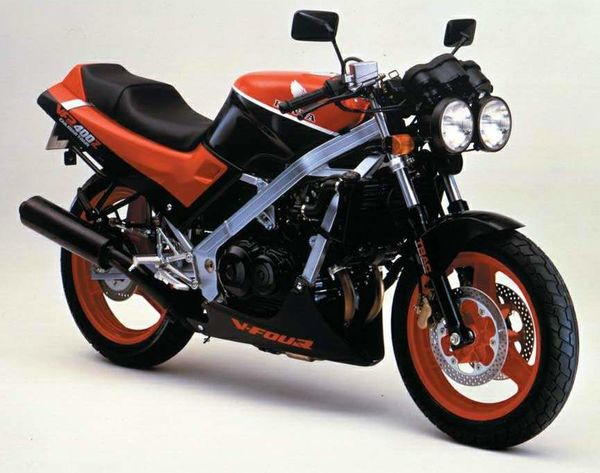Honda VFR400Z
 |
|
| Honda VFR400Z | |
| Manufacturer | |
|---|---|
| Production | 1987 |
| Class | Power Cruiser |
| Engine | Four stroke 90°V-four cylinder, DOHC, 4 valves per cylinder |
| Compression ratio | 11.3:1 |
| Ignition | Digitalized full transistor ignition |
| Spark Plug | NGK ER9EH |
| Transmission | 6 Speed |
| Frame | Twin-spar aluminum |
| Suspension | Front: 41mm inverted forks: preload and rebound damping Rear: Rising-rate monoshock: pre-load and rebound damping |
| Brakes | Front: 2x 269mm 4 piston calipers Rear: Single disc 2 piston caliper |
| Front Tire | 100/90 R16 |
| Rear Tire | 140/60 R18 |
| Wheelbase | 1345 mm / 53.0 in |
| Seat Height | 870 mm / 30.7 in |
| Weight | 170 kg / 374.7 lbs (dry), |
| Oil Capacity | 2.4 Liters |
| Recommended Oil | Honda GN4 10W-40 |
| Fuel Capacity | 18 Liters / 4.0 gal |
| Manuals | Service Manual |
Engine[edit | edit source]
The engine was a Liquid cooled cooled Four stroke 90°V-four cylinder, DOHC, 4 valves per cylinder. The engine featured a 11.3:1 compression ratio.
Drive[edit | edit source]
Power was moderated via the Wet, cable operated.
Chassis[edit | edit source]
It came with a 100/90 R16 front tire and a 140/60 R18 rear tire. Stopping was achieved via 2x 269mm 4 piston calipers in the front and a Single disc 2 piston caliper in the rear. The front suspension was a 41mm inverted forks: preload and rebound damping while the rear was equipped with a Rising-rate monoshock: pre-load and rebound damping. The VFR400Z was fitted with a 18 Liters / 4.0 gal fuel tank. The bike weighed just 170 kg / 374.7 lbs. The wheelbase was 1345 mm / 53.0 in long.
Photos[edit | edit source]
Overview[edit | edit source]
Honda VFR 400Z
Model History
The Honda VFR400 series of motorcycles were a related series of 399 cc V4-engined motorcycles, which were essentially scaled-down versions of the larger VFR race models of the day. They were mainly developed for, and sold in, the Japanese domestic market, in part due to the tougher motorcycle drivers' license restrictions in Japan at the time for bike exceeding 400cc.
Outside Japan, the VFR400R (NC30) was officially imported to the United Kingdom for four years, but with a price tag of £5899 (similar to that of the 1000 cc bikes of the time and actually more than Honda's own VFR750F), failed to sell well. This model was also officially imported (in very limited numbers) and sold in Austria, France and Germany for a few years.
Although mainly produced for the Japanese domestic market, VFR400s have been popular as grey imports in other markets (especially so for the NC30 in the United Kingdom, and also for racing purposes in the United States) in the "mini" superbike segment.
VFR400 engines produce a noticeable whine when the engine is running, due to the cams being driven by straight cut gears, rather than chains or belts.
The first generation of VFR400R was the 19861987 NC21, which had replaced the VF400F when the Honda VF series was phased out (mainly due to reliability issues with the head and cam chain). This model had a full fairing, single headlight, a conventional dual-sided swing arm with single shock. The clutch was hydraulically actuated and the front forks featured Hondas TRAC (Torque Reactive Anti-dive Circuit) system. The engine was a 180° degree crank firing version, and had a rpm redline of 13000 rpm. It was offered in three color schemes. The NC21 was also available as the VFR400Z, a semi-faired version, and as the VFR400P, a police-specification version. A small number of NC21s (VFR400R) were imported new into New Zealand in 1987.
The 2nd generation of VFR400R was the VFR400R NC24, produced for the 1987 and 1988 model years, the first production Honda motorcycle to utilize an ELF-designed Pro-Arm single-sided swingarm (which later became one of the trademarks of the Honda VFR series). Discontinued with this model were the hydraulically actuated clutch which was switched back to a cable system, and the TRAC anti dive system on the front forks. Styling remained close to the NC21, with the NC24 keeping the single large headlight and the exhaust silencer on the right hand side. This model also had a 180° deg crank firing engine as with the nc21, but redline was raised to 14000 rpm. The NC24 was available in three color schemes in 1987 (including an official Rothmans replica), and one in 1988. Note that the rear wheel on the NC24 was held onto the hub with 4 bolts.
The third generation of VFR400R was the best known version, the VFR400R NC30. This saw styling changes, most notably the headlights were updated to smaller twin headlights, much the same as the RC30, and relocation of the silencer to the left hand side, which gave a more open look to the rear wheel on the right hand side. This model saw the introduction of the 360° crank firing engine, which is also known as the "big bang" engine. The tachometer red-line was also raised to 14500 rpm. The NC30 was also officially sold in limited numbers in several European countries. The official European models were sometimes installed with a different CDI (ignition device), no 180 km/h (110 mph) restriction, speedometer that reached to 240 km/h (150 mph) and larger headlights (Germany). The NC30 was produced between 1989 and 1992, though unsold bikes were still available to purchase from Honda dealers for several years thereafter. The NC30 reflected the styling of its iconic bigger brother, the VFR750R (RC30), right down to its 18-inch rear wheel. Japanese-spec NC30s were available in a total of eight different color schemes, produced with three different model year specifications (1989, 1990 and 1992). Export models were made in two different color schemes, and carried model year designations L and M (1990 and 1991).
The official UK model has the following distinguishable features: slightly larger front and rear direction indicators; additional rear number plate light (separate from rear lamp) oil cooler, 60/55 watt headlamp bulbs, and a MPH speedo. The official UK bikes were only ever available in two color schemes.
The Honda VFR400R NC30 is widely regarded as being a fine handling motorcycle. The engine has a very wide powerband for a 400cc engine, which made it a perfect beginners-superbike. It has a hardcore fanbase, especially in Japan and the UK, where the NC30 is a popular track-day and racing bike. Successors
As the RC30 was eventually replaced by the RVF750R (RC45), the VFR400R NC30 evolved into the RVF400R NC35, which was produced between 1994 and 1996. This model featured inverted forks and an updated racing-style fairing. Speed restriction
In the Japanese market, 400 cc motorcycles were once restricted by top speed, but these restrictions can be removed through various means, including the fitting of an ignition "black box". The VFR400R is restricted by means of an optical sensor inside the speedometer, and a black sector attached to the indicator needle shaft. When needle swings round to 180 km/h (110 mph) the sector starts to block the sensor, ignition is cut to the front two cylinders thereby reducing power such that the motorcycle can not accelerate further.
Some models also had power restrictions, this was most commonly a restriction washer in each of the rubber sections between the carbs and cylinder inlet. Technical specifications Performance
Top speed: 130 mph (210 km/h) Acceleration: 062 mph (100 km/h): 5.0 s
Braking: 620 mph (100 km/h): 4.5 s
Acceleration + Braking - 01000 mph 22.1 s ( As claimed by Performance Bikes magazine )
Source Wikipedia
| Make Model | Honda VFR 400Z |
|---|---|
| Year | 1987 |
| Engine Type | Four stroke 90°V-four cylinder, DOHC, 4 valves per cylinder |
| Displacement | 399 cc / 15.7 cu-in |
| Bore X Stroke | 55 x 42 mm |
| Valve Clearance | Intake - 0.15 mm / Exhaust 0.24 |
| Cooling System | Liquid cooled |
| Compression | 11.3:1 |
| Lubrication | Wet sump |
| Engine Oil | SAE 10W-40 |
| Oil Capacity | 2.4 Liters |
| Induction | 4x 34mm Keihin CV type |
| Ignition | Digitalized full transistor ignition |
| Spark Plug | NGK ER9EH |
| Starting | Electric |
| Max Power | 59.hp / 43.1 kW @ 12800 rpm |
| Max Torque | 39.Nm / 4.0 kgf-m / 28.8 lb-ft @ 10000 rpm |
| Rev Redline | 13000 rpm |
| Clutch | Wet, cable operated |
| Transmission | 6 Speed |
| Final Drive | Chain |
| Frame | Twin-spar aluminum |
| Front Suspension | 41mm inverted forks: preload and rebound damping |
| Fork Oil Per Rod | 390 ml / SAE 7,5W |
| Rear Suspension | Rising-rate monoshock: pre-load and rebound damping |
| Front Brakes | 2x 269mm 4 piston calipers |
| Rear Brakes | Single disc 2 piston caliper |
| Front Tire | 100/90 R16 |
| Rear Tire | 140/60 R18 |
| Rake | 24° |
| Trail | 96 mm / 3.7 in |
| Dimensions | Height 1075 mm / 42.3 in Length 1985 mm / 78.1 in |
| Wheelbase | 1345 mm / 53.0 in |
| Seat Height | 870 mm / 30.7 in |
| Dry Weight | 170 kg / 374.7 lbs |
| Fuel Capacity | 18 Liters / 4.0 gal |

